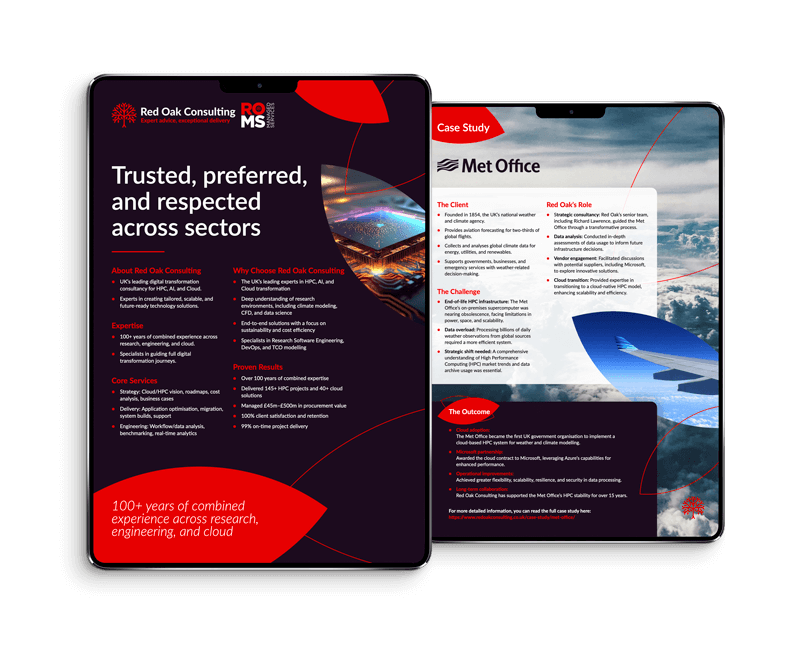After a successful proof-of-concept (PoC) phase, the natural next key milestone is a pilot deployment.
But have you ever wondered why many pilot projects stall before becoming operational? In this post, we’ll walk through the essential stages, questions, and best practices for running a production-grade Cloud HPC Pilot following a successful PoC.
A pilot bridges the gap between experimental validation and full production, allowing you to test near-production conditions, concretise processes, and flush out the hidden risks before committing to full-scale adoption
Defining and running Pilot Projects
A well-scoped pilot mirrors a production environment as closely as possible without requiring every piece to be in place.
It’s less about reinventing architecture and more about confirming that your target design holds up under realistic loads, operational demands and governance requirements. It should feel like and perform like a production system.
As with every project, clarity on objectives and scope is key:

- What workloads and user groups will participate?
- High-throughput batch jobs? MPI based simulations? GPU-accelerated AI training?
- Which software stacks, frameworks, and data pipelines should be exercised?
- Which aspects of the environment, performance, cost, reliability, and security are most critical to validate before committing to a production deployment?
Failing to align the scope with business objectives can lead to an unfocused pilot that neither drives decisions nor uncovers high-impact issues.
Align Governance and Stakeholders
Key stakeholders from the PoC should be involved, as well as wider involvement from other business functions:
- Identify key sponsors from management, engineering, finance, security, and end-users.
- Establish a steering committee to review milestones and approve go/no-go decisions.
- Appoint an executive sponsor and user and domain specific champions.
- Define communication cadences, weekly updates, demos, and retrospective sessions.
A transparent governance model ensures rapid feedback loops, shared ownership in the pilot’s success and buy-in.
Understand Business Objectives
Even in a pilot, the end game is to deliver business value. Without a clear line of sight to outcomes, whether that’s faster time-to-solution, resource utilisation, or improved user productivity, you should not risk running an engineering exercise in a vacuum.
- Articulate the expected benefits: e.g. reduced job waiting times (better time to solution), improved on-demand (burst) capacity, or simplified operation and maintenance (compared to an on-premises environment).
- Map success metrics back to organisational goals: e.g. revenue impact, time to market, improved productivity.
- Clarify decision criteria for scaling: minimal acceptable performance, available scale and total cost of ownership, or compliance requirements.
When management, finance, IT, and users share the same targets, the pilot becomes the decisive factor in agreeing about a production rollout.
Define Clear Success Criteria
Your pilot succeeds only if you know how to measure success. Success criteria must be SMART: specific, measurable, achievable, relevant, and time-bound.
Further, there will be a range of technical and non-technical criteria as well as functional and non-functional requirements. Depending on the business criticality of the service, some of these will come with service-level commitments.
Technical criteria examples
- End-to-end job completion within target service level (SLA)
- Job waiting times, scaling efficiency, I/O latency or bandwidth
- Data ingest and egress times under predetermined limits
Scale and capacity requirements sufficient to meet demand
Business Criteria
- User satisfaction ratings above a defined threshold
- Cost-per-job or cost-per-core-hour within budget
- Onboarding time for new user groups met
Pair each criterion with test cases and pass/fail thresholds, no ambiguity allowed.
Engineering the Pilot Environment
Re-use as many of your PoC artefacts as possible, but in general, a pilot means greater automation, configuration management, and production-grade security.
Architecture and Infrastructure
Pilots usually mean testing at a scale equivalent to or sufficient to demonstrate the capability and capacity required for the production system.
- Compute: VM instance types that represent your expected production fleet.
- Storage: parallel filesystems, object stores, or mixed models matching your capacity, performance and expected I/O needs.
- Networking: virtual private networks, subnets, and security groups configured to replicate your target topology and needs.
- Identity and Access Management (IDAM): A pilot should always use the expected IDAM methods, as well as VPNs and virtual/remote desktop environments.
Automation and Infrastructure-as-Code
One of the key changes between a PoC and a pilot environment is automation and reproducibility.
If you are not familiar with the concept of regression testing, for both functional and performance, it becomes a useful tool to manage the process or software patching, application version control etc.
- Use Cloud native templates or IaC platforms such as Terraform, to provision every component.
- Integrate with DevOps workflows so infrastructure changes pass through code review and CI pipelines.
- Leverage Ansible or Chef for post-provisioning configuration, patching, and software installation on images.
Data Management
A common difference between a PoC and a pilot environment is that when running at scale, the storage systems have to deal with not just greater volumes of data, but many more concurrent jobs and the associated noisy neighbour interactions that can occur.
- Provision test datasets that mimic scale, diversity, and access patterns similar to the production data (ideally, use actual production data and ingestion pipelines).
- Automate secure transfers and sanitisation steps to protect sensitive information.
- Validate data persistence across failovers and regional outages if applicable (High Availability and Disaster Recovery processes are only as good as the testing they undergo).
Evaluating Pilot Performance
With the Pilot environment in place, shift to systematic evaluation phase. This is where you validate your design and discover any rough edges needed before a full production deployment. Bring actual users to help conduct this phase of testing.
Performance and Scalability Tests
- Run benchmark suites covering your most common workloads.
- Conduct Amdahl’s and Gustafson’s Law analyses to understand scaling limits (arguably, this should be something that is extracted from the PoC phase).
- Run multiple actual production workloads concurrently to stress test the environment.
Cost and Financial Metrics
- Track cost per job, cost per node-hour, and cost per terabyte-month.
- Compare on-demand, reserved, and spot pricing models under realistic consumption patterns.
- Refine your total cost of ownership (TCO) model to match the observed metrics.
Resilience and Supportability
- Simulate failures: node crashes, network partitions, service API errors.
- Verify monitoring and alerting pipelines: use Prometheus, Grafana, or cloud-native tools.
- Exercise runbook procedures: on-call rotations, escalation paths, recovery playbooks.
Decision to Production
Armed with Pilot data, convene stakeholders to assess readiness. A robust decision process hinges on three elements:
- Did the pilot meet or exceed all technical and business success criteria?
- Are operational processes, including onboarding, monitoring, and incident response, sufficiently battle-tested and documented?
- Can ongoing costs and future scale-up requirements be absorbed by existing budgets and governance structures?
If the pilot reveals critical blockers, treat them as enhancements to the design rather than failures. Iterate rapidly, retest, and reconvene until the production deployment gate criteria are satisfied.
Cloud-Specific Considerations
While many pilot principles mirror on-premises practices, the Cloud HPC adds its own twists:
Vendor Lock-In and Portability
- Do you need to retain the option to switch providers?
- Will abstraction layers (e.g., Slurm-as-a-Service) justify the additional complexity?
Security, Compliance, and Data Sovereignty
- Ensure your pilot environment meets any commercial, industry and regulatory compliance requirements: e.g. GDPR, HIPAA, or export controls.
- Validate identity and access management (IAM) roles, policies, and audit trails.
Cost Optimisation Strategies
- Autoscaling vs. fixed-size clusters: which aligns best with your usage variability?
- Balance pay-as-you-go (PAYG) with reserved instance (RI) usage.
- Spot or preemptible instances for non-critical or checkpoint-restart workflows.
- Scheduled scaling windows for predictable workloads to lock in discounts.
Continuous Improvement and Next Steps
A pilot isn’t a one-and-done exercise. Use it as the foundation for:
- Documented runbooks and standard operating procedures.
- Sprint-driven enhancements to automation and monitoring.
- Ongoing benchmarking to catch performance regressions or cost spikes.
- Evergreening of cloud estate is necessary (within constraints of billing structures) to ensure optimal price and performance.
Once you’ve confidently passed the production gate, you’ll have a repeatable, scalable blueprint for delivering an enterprise-grade Cloud HPC environment.

Dairsie Latimer
Technology Fellow
Red Oak Consulting


